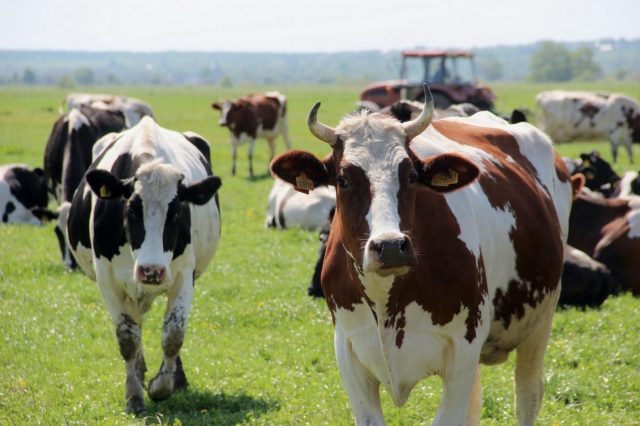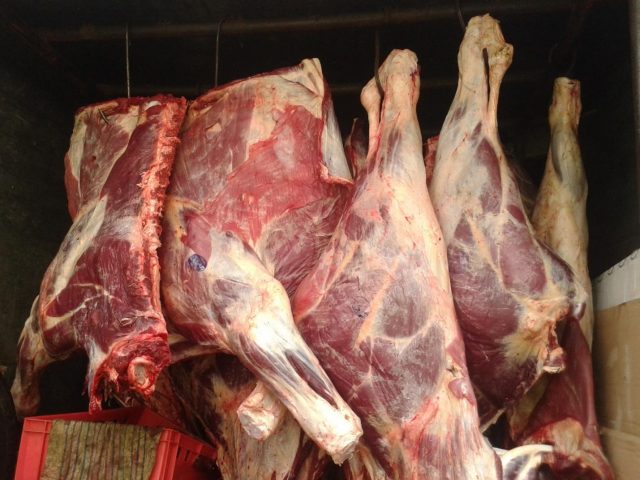Content
The table of cattle meat yield from live weight makes it possible to understand how much meat can be counted on under certain conditions. It is useful for novice livestock breeders to learn about the factors affecting the final amount of production, the possibility of its increase, and, conversely, to understand what contributes to a decrease in the yield of cattle meat.
What is slaughter weight and lethal output
Often, characterizing the productivity of cattle, the term “slaughter meat yield” is used. For many novice breeders, this concept is a real mystery, since not everyone knows what exactly this terminology means. In fact, this concept is due to specific meanings and clear wording. Slaughter weight can vary, which is influenced by the breed and type of pet.
To calculate the parameter it is necessary to deal with one more term - “slaughter weight of an animal”. It is a mistake to assume that this value is equal to the mass of a live bull or calf, since a number of body parts are removed from cattle after slaughter:
- lower legs;
- head;
- leather;
- internal organs;
- intestines.
After cutting the carcass and removing the listed parts, the slaughter weight of the animal is determined.
After that, you can start calculating the slaughter yield of meat, remembering that this concept is also related to the live weight of cattle (the bull is weighed before slaughter) and is indicated as a percentage.
The following factors directly influence the output of products:
- direction of breed productivity - cows bred to obtain large milk yields have a mediocre yield of meat products, and animals bred as meat, on the contrary, cannot give high milk yield, but their meat yield and its quality are several times higher;
- floor - males are always larger and better developed than cows, therefore, the amount of meat they receive is higher;
- age - the younger the representative of cattle, the less the desired result of production, the same applies to old individuals, which for the most part, after one and a half years, begin to gain a layer of adipose tissue;
- physiological condition - the healthier the cattle, the faster and better it gains weight.
Slaughter yield table for cattle
Since the live weight of cattle and the final meat yield are interrelated, some standard indicators need to be known. Each breed has its own characteristics, but all representatives of cattle are united by one thing - the muscles grow in bulls only up to 18 months, then a layer of adipose tissue begins to grow in their place. Therefore, in animal husbandry, bulls are most often raised for slaughter only up to one and a half years.
Average values of slaughter and quality of meat products of different breeds of bulls at the age of one and a half years. The table shows the average statistical indicators that you should rely on when choosing a particular breed.
Breed | Red motley | Kazakh white-headed | Black and motley | Red steppe | Kalmyk | Simmental |
Live weight on the farm | 487.1 kg | 464.8 kg | 462.7 kg | 451.1 kg | 419.6 kg | 522.6 kg |
Weight at the meat processing plant | 479.8 kg | 455.1 kg | 454.4 kg | 442.4 kg | 407.9 kg | 514.3 kg |
Transportation losses | 7.3 kg | 9.7 kg | 8.3 kg | 8.7 kg | 11.7 kg | 8.3 kg |
Carcass weight | 253.5 kg | 253.5 kg | 236.4 kg | 235 kg | 222.3 kg | 278.6 kg |
Mascara exit | 52,8% | 55,7% | 52% | 53,1% | 54,5% | 54,2% |
Internal fat content | 10.7 kg | 13.2 kg | 8.7 kg | 11.5 kg | 12.3 kg | 12.1 kg |
Internal fat release | 4,2% | 5,2% | 3,7% | 4,9% | 5,6% | 4,3% |
Slaughter weight | 264.2 kg | 2bb, 7 kg | 245.2 kg | 246.5 kg | 234.7 kg | 290.7 kg |
Slaughter exit | 55,1% | 58,6% | 54% | 55,7% | 57,5% | 56,5% |
Internal fat yield in relation to the carcass | 4,2% | 5,2% | 3,7% | 4,9% | 5,6% | 4,3% |
The meat yield indicated in the cattle table allows you to find out the average value of the finished product, which a breeder can count on when purchasing and growing a particular breed, taking as a basis the live weight of a particular animal.
How much meat is in a bull
It is known that it is bulls that are most often bred for slaughter and for obtaining meat products. This is due to their anatomical features. Therefore, it is important for novice livestock breeders to know how much a live bull can weigh, how the body condition of the animal is assessed, and what it depends on.
There are several categories of cattle body condition:
- First or highest category (live weight at least 450 kg) - the cattle has developed muscle mass, the body has rounded lines, the shoulder blades practically do not protrude, the spinous processes of the vertebrae are smoothed. Not noticeably protruding cranks and ischial tubercles. In castrated bulls, the scrotum area is filled with fat. There are layers of fat all over the body.
- Second category - live weight from 350 to 450 kg. The muscles of the animal are well developed, the contours of the body are slightly angular, the shoulder blades are slightly prominent. Spinous processes, maclaki and ischial tubercles are noticeable. A layer of fat can be observed only on the ischial tubercles and near the base of the tail.
- Third category - live weight less than 350 kg. The musculature of cattle is poorly developed, the body is angular, the hips are tightened, all the bones of the skeleton are prominent, there is no fat layer.
Representatives of the first two categories are selected for slaughter. Gobies from the third category are discarded.
Conclusion
The Live Weight Table of Cattle Meat Yields is a visual aid for breeders to understand the dependence of the expected production on numerous factors.











How to correctly calculate the meat yield after deboning? What is the formula for calculating the percentage of shrinkage
Good day!
For a more accurate answer, you need to clarify the information.
• The meat yield of which livestock do you need to calculate?
• Calculate the percentage of shrinkage: when cooling fresh meat, during storage, freezing, heat treatment?
• In what conditions and how do you intend to store the meat (provided that the percentage of shrinkage must be calculated when storing or freezing meat)?
Good evening! Received cow meat for 227,600 kg * 180 manat = 40 968 m.
After one for again weighed and it turned out - 223,700 kg, loss - 3,900 kg. 1.7%
Then they did a dew and it came out
pulp - 125,800 kg
bone - 82,300 kg
waste - 14,700 kg
after deboning, loss of 0.900 kg.
I sell bones at 60 m per kg.
retreat 10 m per kg.
How to calculate the cost of pure meat (pulp)?